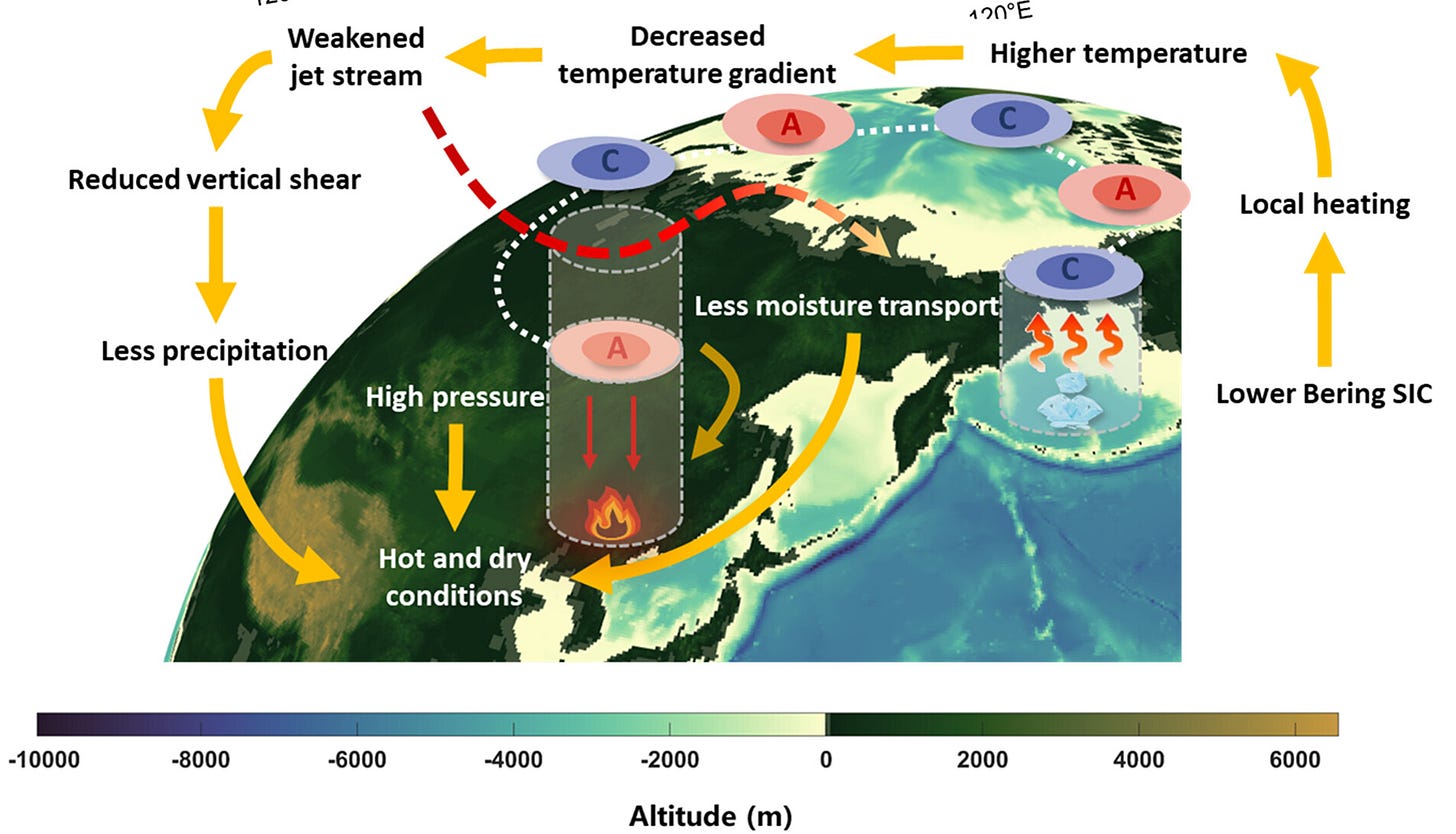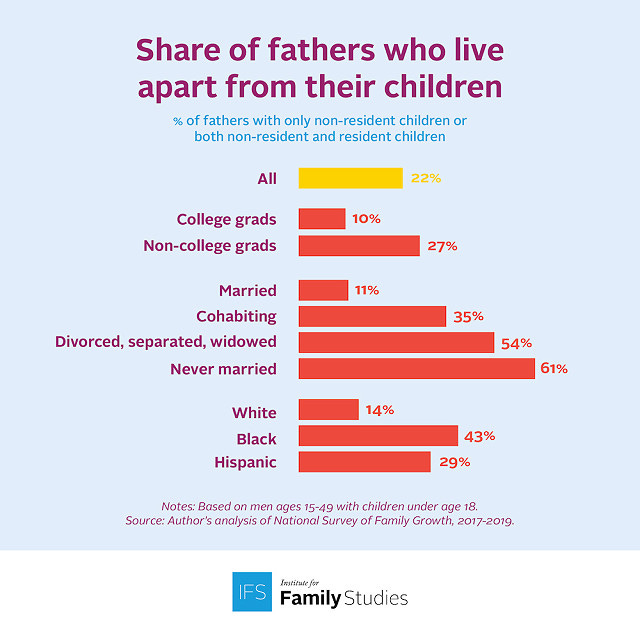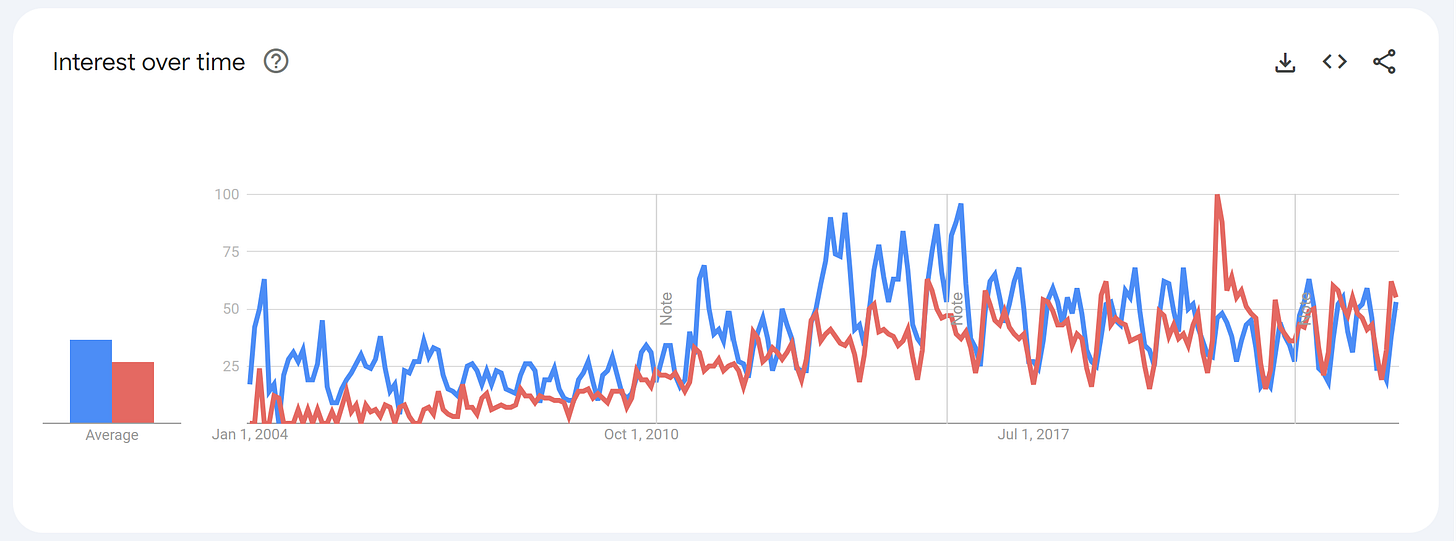Quick Takes and Random Stuff Oct 26, 2023
Jet stream, fathers, wealth inequality, Google searches, and more
Graph of the week
This graph comes from the paper Increasing Fire Weather Potential Over Northeast China Linked to Declining Bering Sea Ice (10/5/2023). Here is an explanation of the graph (SIC is sea ice concentration).
Reduced Bering SIC in FAM leads to warmer Bering Sea due to ice-albedo feedback shown in both reanalysis data sets and simulation (Figures S7a and S7b in Supporting Information S1). This temperature increase weakens the meridional temperature gradient between lower latitudes and the Arctic region (Figures S7c and S7d in Supporting Information S1). Consequently, the thermal wind relationship exhibits a negative anomaly in the westerly winds in the upper troposphere at mid-latitudes (Figures 3a and 3b), indicating a weakened subtropical jet stream. This results in a weakened vertical wind shear in the NEC, which is unfavorable for the development of vertical convection. This condition further reduces atmospheric instability, making the condensation of water vapor less likely to form clouds or precipitation, thereby decreasing precipitation.
There are real impacts of climate change that we understand or are understanding better, if not completely. Here are the key points from the paper:
The escalation of fire in Northeast China during the past decade is strongly linked with the decline of Bering Sea ice concentration
Weakened vertical wind shear, the high-pressure center and northerly winds induced by warmer Bering Sea might explain the teleconnection
This linkage could potentially be intensified in a warmer world
Changing temperature gradients that occur with melting ice and warmer northern temperatures do impact the jet stream. This video is about 10 years old, but it is still very good and worth your 5 minutes if you want to understand the jet stream and how it is changing.
2022 wealth inequality
The People’s Policy Project released their Wealth Distribution 2022 (10/23/2023) report.
Overall, wealth inequality remains quite high. The top 10 percent of households own 73 percent of the nation’s wealth while the bottom 50 percent of households own just 2 percent of the nation’s wealth.
There are a number of graphs, but here is the one that caught my attention. The bottom decile has a greater percentage of college graduates than the 2nd, 3rd, and 4th deciles. The 5th, 6th, and 7th deciles have more college graduates than the 1st, but not a lot more. Be careful of the logic here. We can say that about 1/3 of those with the least wealth are college graduates. On the other hand, college graduates are much more likely to be in the top deciles. The other interesting aspect is how some college is about the same from deciles 2 through 8, with 1 being only a bit larger.
Good read
World politics isn’t my area, but I will say The Day the Delusions Died is worth reading, if for no other reason than the quotes from Thomas Sowell.
Those with “unconstrained vision” think that humans are malleable and can be perfected. They believe that social ills and evils can be overcome through collective action that encourages humans to behave better. To subscribers of this view, poverty, crime, inequality, and war are not inevitable. Rather, they are puzzles that can be solved. We need only to say the right things, enact the right policies, and spend enough money, and we will suffer these social ills no more. This worldview is the foundation of the progressive mindset.
By contrast, those who see the world through a “constrained vision” lens believe that human nature is a universal constant. No amount of social engineering can change the sober reality of human self-interest, or the fact that human empathy and social resources are necessarily scarce. People who see things this way believe that most political and social problems will never be “solved”; they can only be managed. This approach is the bedrock of the conservative worldview.
One more:
As Sowell explained, “When you want to help people, you tell them the truth. When you want to help yourself, you tell them what they want to hear.”
Fathers stepping up
The IFS article American Dads Are More Involved Than Ever—Especially College-Educated or Married Dads (10/24/2023) has some data worth reporting out. First,
American fathers are more involved in their children’s lives than ever. Fathers in America now spend an average of 7.8 hours per week taking care of their children at home, up by 1 hour per week in just about two decades. (Mothers’ child care time remains stable during this period.) However, this rise in fathers’ parenting time does not apply to all dads.
The average here is a little misleading because college-educated dads increased from 7.9 to 10.2 hours per week, while non-college-educated dads went down from 6.2 hours to 5.9 hours. As for which dads are living with their kids, we have this graph
What we see is a large cultural difference between college-educated and non-college-educated fathers, which extends to families. Similarly, there are large cultural differences between races, which are connected to education. This is something liberals don’t want to talk about but should. There are benefits to having two present and married parents.
Another oil merger
Chevron buys Hess for $53B in second mega oil merger this month. See my post on Tuesday, IEA Monthly Oil and Gas Overview, for my comment on the ExxonMobil buy. Oil seems to still be good business.
Google searches for inequality
Marginal Revolutions posted this graph of Google searches for the word inequality with this comment:
From Jared Sleeper
I was surprised to see this magnitude of effect. Google searches for “inequality” are twice as high during the academic year as they are during the summer. They double in September vs. August and then collapse by 50% in June vs. May.
First, note that all of these graphs are relative percentages of the search term to itself. So 100 is the month the term was searched for the most, and every other month is the percent of that. These are not counts.
It is easy to jump to the conclusion that higher education has students focused on writing papers on inequality. It was noted in the comments that inequality is a broad category, and maybe these searches are not social inequality but something else. Let’s go to the data and see if we can sort it out. Here is the graph for the search phrase graph inequality, which could be for math classes. Not surprisingly, we see a cyclical pattern correlated with classes in session.
Here is one for income inequality, which is a clear term, and we have the same pattern.
Here are income inequality (blue) and graph inequality (red) together.
From November 2013 to May 2016, income inequality was well above graph inequality, but graph inequality spiked in September 2020. This leads me to believe that graph inequality is a term used not entirely for math. Except for these notable differences, the relative use of both terms in searches has been about the same for a decade. One more. I’ll compare linear inequality (blue), clearly math, with income inequality (red). In this case, we see that income inequality is much more prevalent.
I’m not sure I have a great point here, but it is interesting. It would seem that students are searching for inequality more for social reasons than math reasons. I also don’t have a problem with this, as inequality is something students should research; the issue is more the slant that may or may not be placed on the topic in the classroom. The question in my mind is: What other search words are cyclical with classes being in session? Put your thoughts in the comments.
The spinning CD
New Green Day: The American Dream is Killing Me
Please share and like
Please help me find readers by forwarding this article to your friends (and even those who aren't your friends), sharing this post on social media, and clicking like. If you're on Twitter, you can find me at BriefedByData. If you have any article ideas, feedback, or other views, please email me at briefedbydata@substack.com.
Thank you
In a crowded media market, it's hard to get people to read your work. I have a long way to go, and I want to say thank you to everyone who has helped me find and attract subscribers.
Disagreeing and using comments
I'd rather know the truth and understand the world than always be right. I'm not writing to upset or antagonize anyone on purpose, though I guess that could happen. I welcome dissent and disagreement in the comments. We all should be forced to articulate our viewpoints and change our minds when we need to, but we should also know that we can respectfully disagree and move on. So, if you think something said is wrong or misrepresented, then please share your viewpoint in the comments.












